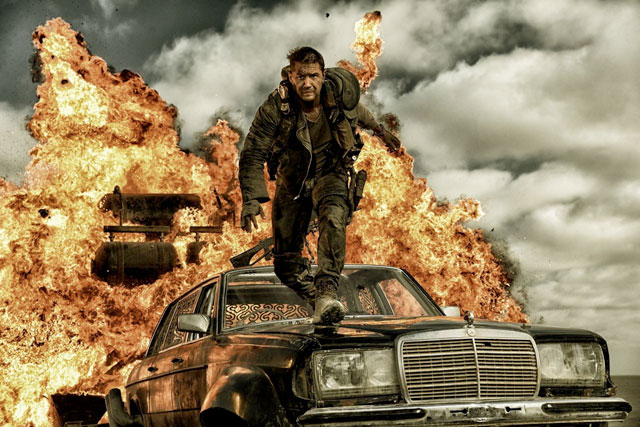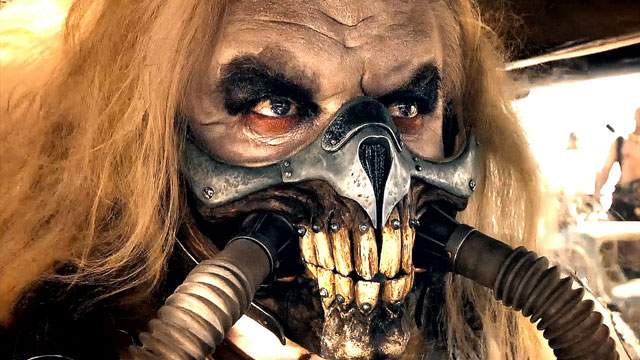
It’s not often that a tent-pole summer film as bonkers as Mad Max: Fury Road comes along, and that’s enough reason to celebrate the return of the Australian road warrior after a 30-year absence from cinema screens. Helmed by George Miller — who directed Mel Gibson in the original trilogy — the new Mad Max film is a cultish oddity made on a blockbuster budget.
Between 1985’s Mad Max: Beyond Thunderdome and Fury Road, Miller has kept himself busy making films about talking pigs and dancing penguins, which makes Fury Road all the more astonishing. Here’s a US$150m feature that seems to have been made with as much as independence of spirit as the famously cheap 1979 production that started the Mad Max series. And that’s despite a difficult and protracted development cycle.
This time, it’s Tom Hardy who takes the role that made Gibson famous, although the hero is upstaged in his own film by Charlize Theron’s shaven-headed, one-armed avenger, Furiosa. It’s a sort of quasi reboot/sequel to the 1980s Mad Max films, which catches up to Max and his post-apocalypse world with a few minutes of murky exposition by voiceover monologue.
After the shaky opening moments, Max is taken captive by the War Boys, a gang of marauders led by the warlord Immortan Joe, and we’re off to the races. Literally. The film is a two-hour there-and-back car chase that sees Immortan Joe in hot pursuit of Max and Imperator Furiosa as they try to help his five wives escape from his evil, patriarchal grip.
Hardy’s Max is a survivor — a taciturn loner tortured by visions of those he failed to save. He finds the broken man inside the hero in a soulful performance that sees Max slowly reconnect to his humanity through an allegiance with Furiosa. In a neat touch, Joe is played by Hugh Keays-Byrne, who was Toecutter in Mad Max 1, though rendered unrecognisable under a toothy breathing mask and a mane of white hair.

Theron is magnificent as the wily and resourceful Furiosa, making for a striking figure with her close-cropped hair and the smear of black oil that masks her eyes. She’s bound to stand next Sigourney Weaver’s Ellen Ripley and Linda Hamilton’s Sarah Connor in any future lists of great female heroes in action film. Nicholas Hoult, as the War Boy Nux, is also good. His “What a lovely day” dialogue looks set to become as embedded in popular culture as the night rider speech from the original Mad Max film.
Miller’s film strips his characters down to archetypes, his plot down to the propulsive motion of a mad convoy chasing its prey through the desert, his sparse dialogue down to grunts, meaningful glances, and the throaty revving of car engines. Like The Road Warrior (Mad Max 2), Fury Road is more concerned with spectacle and mythology than it is with story and characterisation.
But that doesn’t mean that the carnage is without meaning or that action carries no emotional weight. Indeed, Fury Road’s script offers something as spare and elemental as the existential road movies of the 1970s (think Vanishing Point), while the set pieces are as carefully choreographed as a Cirque du Soleil production.
The chase across the wasteland — freaks with pallid skin atop vehicles welded together from disparate parts, Frankenstein-style pursuing Furiosa’s rig — feels less like a Michael Bay-style pummeling by visual effects than a rock concert that finds a particularly good groove. The War Boys charge into battle with a shredding guitarist and some mighty amps astride one of their vehicles while war drummers pound the skins on another — this is the end of the world as a rock opera.
Miller’s visual work is one key to Fury Road’s success. Relying more on practical effects than CGI and meticulously storyboarded, this isn’t chaos cinema, but old-school action filmmaking where the stunts are largely real and where physics have the weight of the real world. And the production design is superlative with outrageous car designs and costumes — think Terry Gilliam directing a heavy metal music video.

It’s a mad apocalyptic world that Miller creates, one where bullets are scarce and gasoline reserves are low, yet the crazies think nothing of chasing down petrol with a foot flat on the accelerator or of firing off machine gun rounds into the air when they’ve been angered. Yet the most precious commodities in the film are human beings treated as property by the powerful: Max captured as a human “blood bag”, women farmed as milk cows, Joe’s concubine called “breeders”, even the War Boys serving as little more than muscle for a tyrant.
The gender politics are simplistic and heavy-handed, perhaps — the binary of nurturing women and destructive men Fury Road proposes is rather reductive — but there’s something brave and pure about the new Mad Max film. It remains true to Max’s origins in 1970s schlock-and-shock cinema and yet finds a way to make him relevant to the 21st century. Let’s hope it’s not another 30 years to the next film in the series. — © 2015 NewsCentral Media

